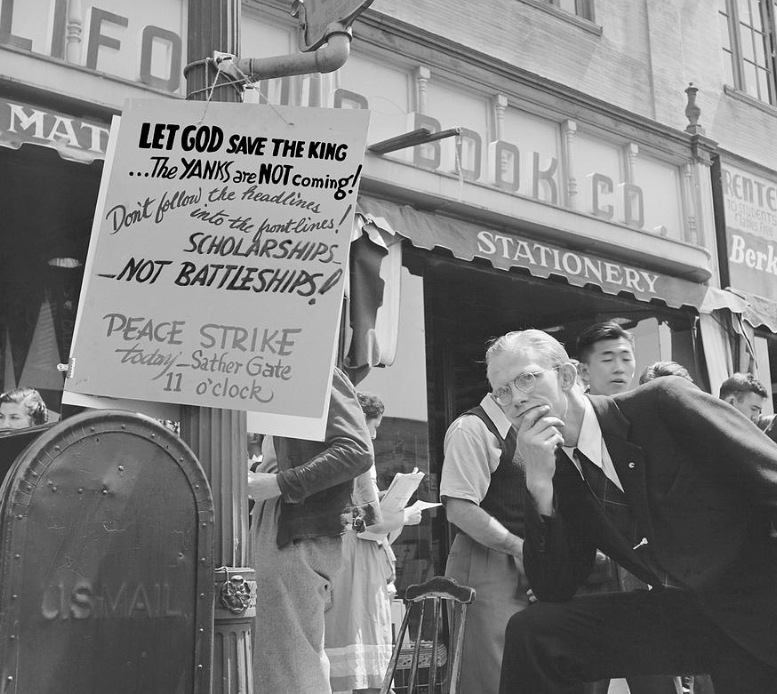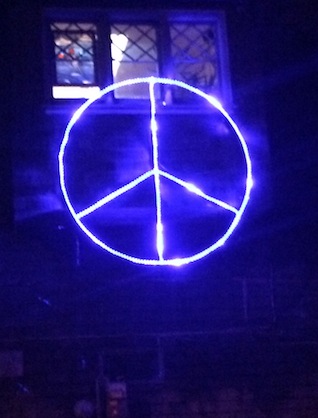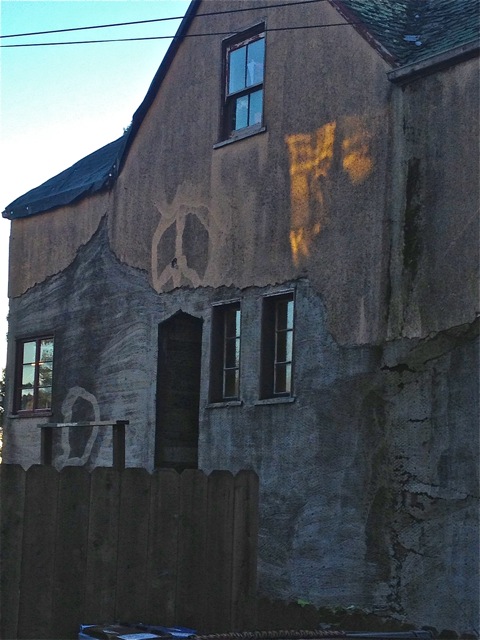In the 1960s and 1970s, Berkeley was an epicenter of the anti-war and peace movements. While I would not go so far as to say that the hope for peace is old-fashioned today, the once-ubiquitous peace symbols and other proclamations in support of peace are becoming relics. But in Berkeley we didn’t get the memo. I suspect that we are the peace sign capital of the United States.
Some are high-profile, like the Hog Farm’s peace symbol on Berryman. Most are personal. Extra credit will be given if you listen to Cat Stevens sing “Peace Train” or John Lennon and Yoko Ono sing “Give Peace a Chance” or the Chad Mitchell Trio sing “Last Night I had the Strangest Dream” or Mahalia Jackson sing “Down by the Riverside” when you view these images. Double extra credit if you listen to Yusuf Islam’s live “Peace Train” or the Johnny Cash version of “Last Night I had the Strangest Dream.” Go, though, give these peace signs a chance.
Peace has been around Berkeley for a while. In 1940, progressive students joined Isolationists in opposing the war.
Here, Cal students rallied in 1940 against the draft. And in 1961 a most curious float joined an otherwise apolitical parade down Shattuck, opposing nuclear weapons testing.
We took peace seriously during the Vietnam war. And, more relevantly here, we took our peace signs and peace symbols seriously.
Thinking globally and acting locally, we incorporated peace into municipal politics, as seen in this 1971 poster:
We still dig peace and peace symbols. We have peace festivals – lots of different ones. We have raised a peace flag on International Conscientious Objectors’ Day.
We have an official Peace and Justice Commission. We celebrate an annual Peace Symbol anniversary. When we still had a “How Berkeley Can You Be?” parade, we had, naturally, a big peace float.
And in the parade we had peace signs on vehicles, prominently, proudly, and boldly. These photos are from the 2007 How Berkeley Can You Be parade. I didn’t take them, Bryan Costales did:
Our Court Jester, Wavy Gravy loves peace, and shows it:
Behind City Hall we have a Peace Wall.
Built in the late 1980s, retiled in 2012. Thousands of hand-painted tiles created by grade school students who are now well into middle age. Skateboarding is legal. There are two skateable ledges with metal coping. And there are many peace symbols. I count more than 70 tiles with the peace symbol. There are more, I am sure. Here are several:
This is not our only peace wall. Anybody can have one peace wall. We have a couple more. At the Ashkenaz Music and Dance Community Center at 1317 San Pablo, we find a stunning tiled peace wall:
The Ashkenaz peace wall is in good company – a big peace sign dominates the Ashkenaz facade.
The self-described World Wall of Peace is located at 2516 Martin Luther King Jr. Boulevard. Modest, but peaceful:
And then there is the wooden fence at 1034 Pardee, devoted to literature and images of progressive causes, including, of course, peace. I consider this Democracy Wall to be a Major Quirky Place of Importance and will cover it more thoroughly later, but for now, the peace:



Enough with the walls. We find peace signs on homes in all neighborhoods of Berkeley. Lets start with the big ones, and start with the biggest, the peace sign on the Hog Farm’s Berkeley compound near Live Oak Park:
And that same sign at night:
- Okay. Enough already. Let’s give peace a break. More soon. Doves and peace flags and peace poles and vehicles and windows and hubcaps and garlic cloves and oh so much more.

































































